A radionuclide is a nuclide that has excess nuclear energy, making it unstable. This excess energy can be used in one of three ways: emitted from the nucleus as gamma radiation; transferred to one of its electrons to release it as a conversion electron; or used to create and emit a new particle from the nucleus. During those processes, the radionuclide is said to undergo radioactive decay. These emissions are considered ionizing radiation because they are powerful enough to liberate an electron from another atom. The radioactive decay can produce a stable nuclide or will sometimes produce a new unstable radionuclide which may undergo further decay. Radioactive decay is a random process at the level of single atoms: it is impossible to predict when one particular atom will decay. However, for a collection of atoms of a single nuclide the decay rate, and thus the half-life (t1/2) for that collection, can be calculated from their measured decay constants. The range of the half-lives of radioactive atoms has no known limits and spans a time range of over 55 orders of magnitude.
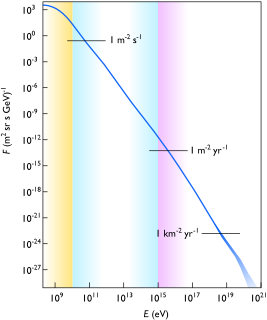
Cosmic rays are high-energy protons and atomic nuclei that move through space at nearly the speed of light. They originate from the Sun, from outside of the Solar System in our own galaxy, and from distant galaxies. Upon impact with Earth's atmosphere, cosmic rays produce showers of secondary particles, some of which reach the surface, although the bulk is deflected off into space by the magnetosphere or the heliosphere.
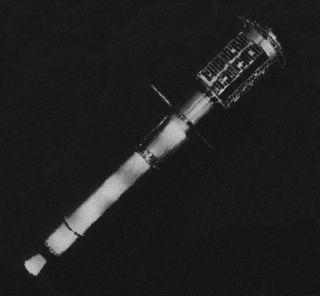
Explorer 11 was a NASA satellite that carried the first space-borne gamma-ray telescope. This marked the beginning of space gamma-ray astronomy. Launched on 27 April 1961 by a Juno II, the satellite returned data until 17 November 1961, when power supply problems ended the science mission. During the spacecraft's seven-month lifespan it detected twenty-two events from gamma-rays and approximately 22,000 events from cosmic radiation.
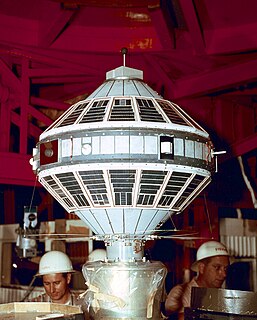
Explorer 7 was a NASA satellite launched on 13 October 1959, at 15:30:04 GMT, by a Juno II launch vehicle from Cape Canaveral Air Force Station (CCAFS) to an orbit of 573 × 1,073 km (356 × 667 mi) and inclination of 50.27°. It was designed to measure solar X-ray and Lyman-alpha flux, trapped energetic particles, and heavy primary cosmic rays. Secondary objectives included collecting data on micrometeoroid penetration, molecular sputtering and studying the Earth-atmosphere heat balance.
The Extreme Universe Space Observatory onboard Japanese Experiment Module (JEM-EUSO) is the first space mission concept devoted to the investigation of cosmic rays and neutrinos of extreme energy (E > 5×1019 eV). Using the Earth's atmosphere as a giant detector, the detection is performed by looking at the streak of fluorescence produced when such a particle interacts with the Earth's atmosphere.

The Pierre Auger Observatory is an international cosmic ray observatory in Argentina designed to detect ultra-high-energy cosmic rays: sub-atomic particles traveling nearly at the speed of light and each with energies beyond 1018 eV. In Earth's atmosphere such particles interact with air nuclei and produce various other particles. These effect particles (called an "air shower") can be detected and measured. But since these high energy particles have an estimated arrival rate of just 1 per km2 per century, the Auger Observatory has created a detection area of 3,000 km2 (1,200 sq mi)—the size of Rhode Island, or Luxembourg—in order to record a large number of these events. It is located in the western Mendoza Province, Argentina, near the Andes.

A neutrino detector is a physics apparatus which is designed to study neutrinos. Because neutrinos only weakly interact with other particles of matter, neutrino detectors must be very large to detect a significant number of neutrinos. Neutrino detectors are often built underground, to isolate the detector from cosmic rays and other background radiation. The field of neutrino astronomy is still very much in its infancy – the only confirmed extraterrestrial sources as of 2018 are the Sun and the supernova 1987A in the nearby Large Magellanic Cloud. Another likely source is the blazar TXS 0506+056 about 3.7 billion light years away. Neutrino observatories will "give astronomers fresh eyes with which to study the universe".
Astroparticle physics, also called particle astrophysics, is a branch of particle physics that studies elementary particles of astronomical origin and their relation to astrophysics and cosmology. It is a relatively new field of research emerging at the intersection of particle physics, astronomy, astrophysics, detector physics, relativity, solid state physics, and cosmology. Partly motivated by the discovery of neutrino oscillation, the field has undergone rapid development, both theoretically and experimentally, since the early 2000s.
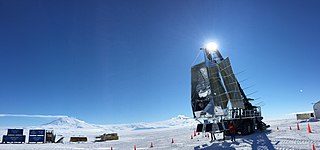
Spider is a balloon-borne experiment designed to search for primordial gravitational waves imprinted on the cosmic microwave background (CMB). Measuring the strength of this signal puts limits on inflationary theory.
Milagro was a ground-based water Cherenkov radiation telescope situated in the Jemez Mountains near Los Alamos, New Mexico at the Fenton Hill Observatory site. It was primarily designed to detect gamma rays but also detected large numbers of cosmic rays. It operated in the TeV region of the spectrum at an altitude of 2530 m. Like conventional telescopes, Milagro was sensitive to light but the similarities ended there. Whereas "normal" astronomical telescopes view the universe in visible light, Milagro saw the universe at very high energies. The light that Milagro saw was about 1 trillion times more energetic than visible light. While these particles of light, known as photons, are the same as the photons that make up visible light, they behave quite differently due to their high energies.
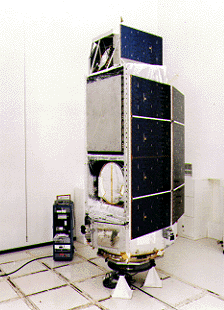
The last of NASA's three High Energy Astronomy Observatories, HEAO 3 was launched 20 September 1979 on an Atlas-Centaur launch vehicle, into a nearly circular, 43.6 degree inclination low Earth orbit with an initial perigeum of 486.4 km. The normal operating mode was a continuous celestial scan, spinning approximately once every 20 min about the spacecraft z-axis, which was nominally pointed at the Sun. Total mass of the observatory at launch was 2,660.0 kilograms (5,864.3 lb).

The Indian Centre for Space Physics (ICSP) is an Indian non-profit research organisation dedicated to carrying out advanced research in astronomy, astrophysics and space science. It is a sister institute of the University of Calcutta. It is located in the southern part of the city of Kolkata. Its new campus is being built on Eastern metropolitan bypass behind Metro Cash and Carry. Its Ionospheric and Earthquake Research Centre (IERC) where a 24-inch optical telescope is being installed there. School and college students regularly carry out sky watching using its 10-inch telescope.
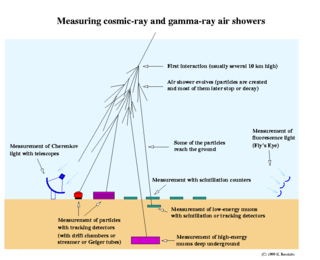
A cosmic-ray observatory is a scientific installation built to detect high-energy-particles coming from space called cosmic rays. This typically includes photons, electrons, protons, and some heavier nuclei, as well as antimatter particles. About 90% of cosmic rays are protons, 9% are alpha particles, and the remaining ~1% are other particles.
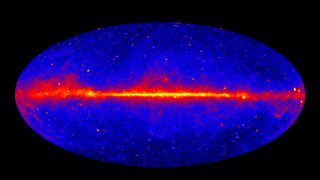
Gamma-ray astronomy is the astronomical observation of gamma rays, the most energetic form of electromagnetic radiation, with photon energies above 100 keV. Radiation below 100 keV is classified as X-rays and is the subject of X-ray astronomy.
PERDaix is a novel, small and light weight magnetic spectrometer to measure the charge and mass dependent solar modulation periodically for deeper understanding of cosmic rays. For a better understanding of sources and acceleration of cosmic particles direct measurements of cosmic rays are necessary. Also for a better understanding of the solar modulation which is expected to follow the 22-year solar cycle, time dependent measurements are needed. PERDaix is a newly designed detector which is constructed by the Department of Physics 1b, RWTH Aachen University. Being proposed to the German Space Agency in November 2009 for a participation in the BEXUS Program after a first canceled flight attempt in October 2010 the actual flight took place as a post-BEXUS-campaign flight opportunity in November 2010.

NEVOD is a neutrino detector and cosmic ray experiment that attempts to detect Cherenkov radiation arising from interactions between water and charged particles. It represents the first attempt to perform such measurements at the Earth's surface; it is because of this surface deployment that the experiment is also able to investigate cosmic rays. NEVOD is situated at the Moscow Engineering Physics Institute (MEPhI).

Explorer 14, also called EPE-B or Energetic Particles Explorer-B, was a NASA spacecraft instrumented to measure cosmic-ray particles, trapped particles, solar wind protons, and magnetospheric and interplanetary magnetic fields. It was the second of the S-3 series of spacecraft, which also included Explorer 12, 14, 15, and 26. It was launched on 2 October 1962, aboard a Thor-Delta launch vehicle.
Cosmic Ray Energetics and Mass (CREAM) is an experiment to determine the composition of cosmic rays up to the 1015 eV (also known as the "knee prospect") in the cosmic ray spectrum.

The Compton Spectrometer and Imager (COSI), is a gamma-ray telescope expected to launch in 2025 as a NASA small astrophysics mission. It is intended to study the recent history of star birth, star death, and the formation of chemical elements in the Milky Way.












